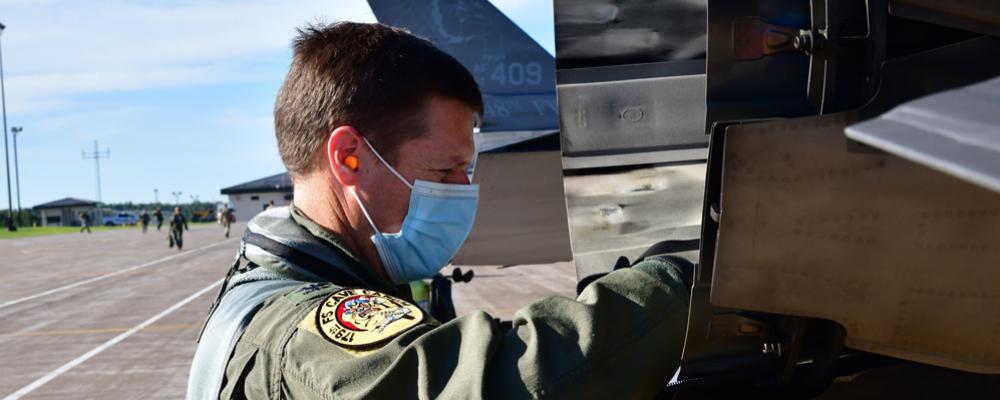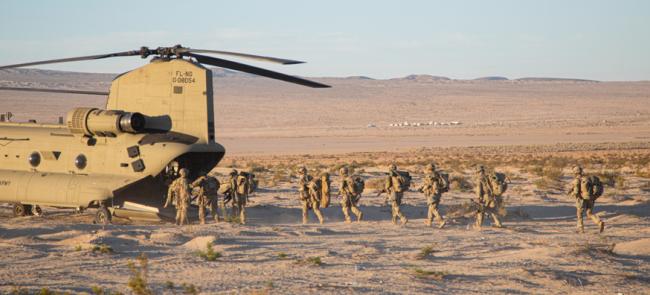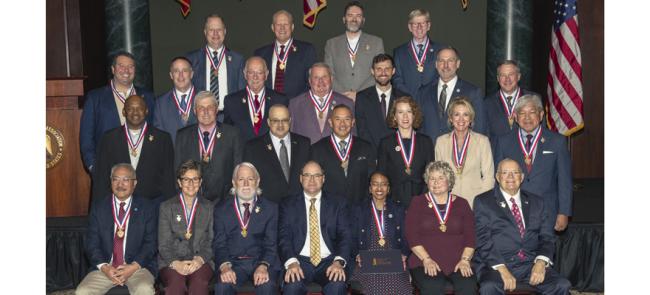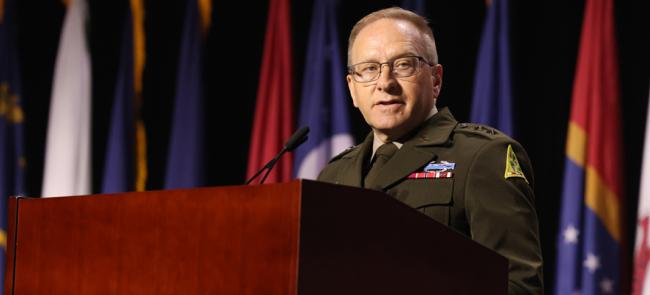
Back At It
Members of the Army National Guard's 81st Stryker Brigade Combat Team had been preparing for months to take the Army’s toughest test of grit, skill and stamina short of combat.
They had completed a series of prerequisite battle drills and exercises. The part-time soldiers had all arranged for three weeks off work or school. And they had loaded all of their vehicles and other heavy equipment on rail cars for the trip to the National Training Center at Fort Irwin, California.
The massive force-on-force exercise set for May in the Mojave Desert was to be the culminating event in their conversion from M1 Abrams tanks to more easily deployed, eight-wheeled Stryker armored fighting vehicles.
They were ready. Then came the novel coronavirus.
In March, the Army temporarily closed NTC and its other combat training centers to slow the spread of COVID-19. The 81st, with units across California, Oregon and, mostly, Washington would stay home.
It was good news for health authorities in California and Washington, where some of the first cases of in the illness in the United States were discovered. They now had more Guardsmen available to help respond to the growing public health crisis.
But brigade leaders had to slam on the breaks and change plans. And gone was the opportunity for the entire 4,000-member unit to test itself in a combat exercise during which the only thing simulated is live ammunition.
“It was extremely disappointing,” says Col. Paul Sellars, the brigade commander. “We had been building up for it for over three years.”
All of its six battalions will still be going to NTC to certify as combat ready — just not together. Each will be attached to another Army brigade training there in the years ahead. But the full brigade won’t go for several years. Only two Guard heavy brigades train at NTC a year, and the 81st is now at the back of the line.
You have to be on the equipment.
—Command Sgt. Maj. Nickolas Lambruno, West Virginia Army National Guard's 1st Battalion, 201st Field Artillery Regiment
SUCH UPHEAVAL ISN’T UNUSUAL THIS YEAR. As many as 46,000 Guardsmen have been involved in the continuing coronavirus response, but the rest of the 450,000-member force have also been affected by COVID-19 as officials take unprecedented measures to slow the spread of the virus.
The Pentagon’s temporary travel ban prevented thousands of Guardsmen from attending schools. Meanwhile, many units sent full-timers home to telework and canceled or significantly altered weekend drills. Others drilled virtually and focused on required annual briefings and admin tasks.
The virtual drills enabled soldiers and airmen to log a “good” month toward yearly training requirements. They also provided a pay check when many were laid off from civilian jobs. But virtual isn’t very valuable to outfits that need to gather and put hands on a weapons system to maintain proficiency.
That’s why some units jumped at the chance to make up for lost time as soon as restrictions eased in their states. Among them was West Virginia’s 1st Battalion, 201st Field Artillery Regiment, which conducted a Super MUTA (multiple unit training assembly) at Camp Dawson, West Virginia, June 13-18.
“Operational skills on the Paladin [self-propelled howitzer] and within the artillery field in general are perishable,” says Command Sgt. Maj. Nickolas Lambruno, the battalion’s senior enlisted member. “Anytime that you don’t train, your skill levels degrade. You have to be on the equipment.”
While the training centered on the unit’s mission-essential task list, much of the planning focused on COVID-19 considerations and how to follow Centers for Disease Control and Prevention guidance in the field.
“Where you would normally request berthing for 300, you now have to request for 600 in order for soldiers to maintain proper social distances while sleeping,” says Maj. Christopher Shamblin, the battalion commander. “Water buffaloes [water-tank trailers] have to be sanitized every 30 minutes for proper use, and staggered chow times and alternate feeding options are needed to keep large numbers of soldiers from eating together.”
Soldiers also had to wear masks and have access to hand sanitizer.
But some other units continued to drill virtually. The California Army Guard’s Cyber Protection Team 171 conducted a drill June 24-28 focused on collective training and building and refining standard operating procedures.
One advantage to a virtual drill: “increasing the level of participation for those personnel who live out of state,” including Idaho, Maryland, Ohio, Texas and Washington, says Maj. Mikael Magnuson, the commander.
“We haven’t changed anything aside from the communication method,” he says. “We still have first formations, team meetings and our training objectives that we must complete.”
Activity at most Air Guard flying wings also picked up in June after brief slowdowns.
“There’s no way the COVID-19 pandemic could not affect operations,” says Col. Andrew “Bishop” Jacobs, commander of the 104th Operations Group, part of the 104th Fighter Wing at Barnes Air National Guard Base in Westfield, Massachusetts. “And I think it’s had an effect from tip to tail. That being said, we have been able to adapt and overcome.”
With telework not an option for those involved in daily flying operations, unit members had to learn to keep six feet apart, which was easier said than done, he says.
“Looking at the maintenance side, it can be very difficult to maintain that separation because some of these jobs are two-person jobs,” Jacobs says, “so they’ve had to take extra precautions such as wearing masks and limiting the time they spend within six feet."
In addition, the wing also now staggers its launches and recoveries of F-15 Eagles to limit the number of airmen on the flight line and the base.
There's no way the COVID-19 pandemic could not affect operations.
—Col. Andrew "Bishop" Jacobs, the commander of the Massachusetts Air National Guard's 104th Operations Group
THE 81ST STRYKER BRIGADE COMBAT TEAM wasn’t the only Army Guard brigade combat team to have its participation in a major exercise cancelled due to COVID-19.
The 116th Cavalry Brigade Combat Team was scheduled to participate in Defender 2020 in Europe. Its involvement was to demonstrate the ability of an armored brigade to deploy from the United States, draw equipment and rapidly build combat forces in Europe.
About 4,000 troops from Idaho, Montana, Nevada and Oregon were scheduled to deploy for a month in late April. About two years of planning had gone into the exercise. In March, the Army told the brigade to stay home.
The move forced leaders in the four states to scramble to come with a new annual training plan for brigade troops.
Officials in Nebraska had to do the same for 1st Squadron, 134th Cavalry Regiment, which had been scheduled to participate in an Exportable Combat Training Capability exercise with the rest of the Arkansas-based 39th Infantry Brigade Combat Team.
Commanders came up with a plan that exercised many platoon-level tasks. But the squadron was unable to train with its heavy weapons, the M2 .50 caliber machine gun and the MK 19 grenade launcher. That could hurt next year during its scheduled rotation at the Joint Readiness Training Center, the NTC equivalent for light brigades at Fort Polk, Louisiana.
“There are plusses and minuses to [missing XCTC],” says Lt. Col. Jeff Searcey, the squadron commander. “The minus of it would be the gunnery piece and the evaluation of the [Situational Training Exercise] lanes they would have had through First Army evaluators.”
One plus, he says, was “more time” for troop commanders, platoon leaders and squad leaders. “They were able to stop, take some time and review their [standard operating procedures] and get those leadership reps in.”
When the Army resumed major training in July, a Guard unit, the Minnesota-based 1st Armored Brigade Combat Team, 34th Infantry Division, was first up at NTC, but with some significant additional procedures to help prevent the spread of the coronavirus.
Extra safety measures — including screening, testing and isolation — were taken even before the troops left their home states, says Brig. Gen. Michael Wickman, the division commander. The efforts increased when soldiers reached Fort Irwin with additional testing and daily checks for COVID-19 symptoms.
Similar lengths were taken during the annual Northern Lightning air combat exercise at Volk Field Air National Guard Base in Camp Douglas, Wisconsin, which concluded Aug. 21.
Fewer participants operated from the base than in past years, and those who did were tested before arriving, tested again on site, and restricted to separate living and work areas. Wisconsin Guard officials also required masks when social distancing was not possible and conducted daily temperature checks and symptom screening.
The two-week training exercise involved nearly 25 units from all across Army, Navy and Air Force. Both fourth- and fifth-generation aircraft participated, including, for the first time, F-35A Lightning IIs from the Vermont Air Guard’s 158th Fighter Wing (story, page 18).
And while the pandemic has hindered training, especially earlier in the spring, it did not prevent the Guard deploying units to the Middle East, including Pennsylvania’s 28th Expeditionary Combat Aviation Brigade and Idaho’s 124th Fighter Wing.
LT. GEN. JON A. JENSEN, the new director of the Army Guard, says it is “no secret” that COVID-19 restrictions have had an impact on the force’s individual and collective readiness.
One metric he cites is 18,000 school slots lost this year, a combination of professional military education, skill and functional schools, and military-occupational-specialty-qualification schools.
“We believe it will take us up to three years to gain back those slots and give educational opportunities to our soldiers,” he says, adding that “personal readiness is the baseline of all other readiness.”
Service schools reopened over the summer. Among them is phase III of the part-time officer candidate school conducted by the Washington Army Guard’s 2nd Battalion, 205th Regional Training Institute at Fort Lewis, Washington. It attracts OCS students from around the country.
During the most recent class, school cadre kept a close eye out for coronavirus infections. They took every student and cadre member’s temperature twice a day during the 16-day course, says Lt. Col. Daniel Raymond, who runs the course.
The effort identified one candidate with signs of a COVID-19 infection. He subsequently tested positive and was quarantined, but has since recovered and can return to the course at a later date, Raymond says. There were no other infections.
He has advice for any commander trying to balance training and mitigating the spread of the virus: be consistent.
“As with any Army operation, we have to enforce the standard,” Raymond says. “Everyone has an opinion on how best to operate during COVID-19, but the commander needs to do an effective risk assessment. Once you’ve determined the appropriate COVID-mitigation efforts, such as masks and distancing, you have to continuously enforce it.”



